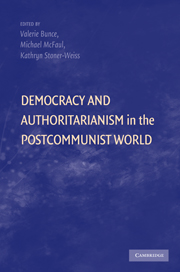Book contents
- Frontmatter
- Contents
- Prologue
- PART I WAVES OF REGIME CHANGE: FROM DICTATORSHIP TO DEMOCRACY…AND BACK?
- PART II ENCOURAGING DEMOCRACY: THE ROLE OF THE EUROPEAN UNION
- PART III CHOOSING REGIME CHANGE: DEMOCRATIZING ELECTIONS
- PART IV RESISTING REFORM: BACKSLIDING DEMOCRACIES AND ENDURING AUTOCRACIES
- Epilogue
- Index
Prologue
Waves and Troughs of Democracy and Dictatorship
Published online by Cambridge University Press: 05 June 2012
- Frontmatter
- Contents
- Prologue
- PART I WAVES OF REGIME CHANGE: FROM DICTATORSHIP TO DEMOCRACY…AND BACK?
- PART II ENCOURAGING DEMOCRACY: THE ROLE OF THE EUROPEAN UNION
- PART III CHOOSING REGIME CHANGE: DEMOCRATIZING ELECTIONS
- PART IV RESISTING REFORM: BACKSLIDING DEMOCRACIES AND ENDURING AUTOCRACIES
- Epilogue
- Index
Summary
DIVERSITY AND TYPICALITY
The experiences of postcommunist Europe and Eurasia over the past two decades contain important lessons about democratization – not just the rise, development, and cross-national spread of democratic orders, but also, just as importantly, the limits of democratic change, the sources of democratic breakdown, and the resilience of authoritarianism. This region is ideal for enriching our understanding of both regime stability and change because it provides the ingredients we need to assess hypotheses and draw generalizations. Thus, although this region shares the important commonality of a communist past, it is also composed, at the same time, of an unusually diverse set of countries, and the differences among them relate precisely to the areas that have figured prominently in debates about the rise and sustainability of democracy. For example, the twenty-nine states that compose this region include both old and new states (with the newest recruits being Montenegro in 2007 and Kosovo in 2008); culturally heterogeneous and homogeneous societies; states with stable borders and states whose borders have been contested since the transition began; national economies that fall into all four categories of development used by the World Bank (low-income, lower-middle-income, upper-middle-income, and high-income states); and both economic and political regime types that run the gamut from “fully free” to “not free” (to use the designations, respectively, of the Wall Street Journal and Freedom House).
- Type
- Chapter
- Information
- Democracy and Authoritarianism in the Postcommunist World , pp. vii - xiiPublisher: Cambridge University PressPrint publication year: 2009

